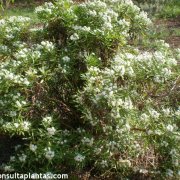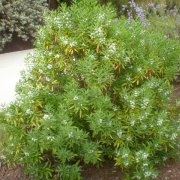Care of the shrub Globularia salicina or Canary Globe flower |
|
The genus Globularia, family Plantaginaceae, comprises 22 species of flowering plants native to central and southern Europe, the Canary Islands, Africa, and Asia. Some species are: Globularia salicina, Globularia alypum, Globularia cordifolia, Globularia punctata, Globularia repens, Globularia trichosantha, Globularia vulgaris. Common name: Canary Globe flower. This species is native to the Canary Islands and Madeira. They are bushes with hanging branches that reach 2 meters (6.56 feet) in height. The leaves are dark green, oval or lanceolate, and leathery in texture. The showy and abundant flowers appear in rounded heads and are blue and white. They bloom for several months in spring and summer. Canary Globe flower is used in rockeries, in pots and planters or hanging on a low wall; it's ideal for Mediterranean coastal gardens. Globularia salicina needs full sun exposure to flower properly. In winter the temperature should not be less than 5 ºC (41 ºF). Canary Globe flower can grow in poor, stony, dry soils but prefer well-drained soil that contains organic matter. It's transplanted from a pot in spring if the roots appear at the base of the container. Always water moderately, waiting for the substrate to dry. In winter water sporadically. Fertilize with compost or manure in the fall. Prune lightly after flowering to maintain a compact appearance. Globularia salicina is a plant very resistant to pests and diseases. Canary Globe flower propagates easily from seeds sown in spring in a seedbed with sandy substrate. |
Images of the shrub Globularia salicina or Canary Globe flower |
Find plants
Globularia salicina or Canary Globe flower | Care and Growing
© 2026 FavThemes





